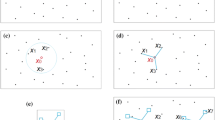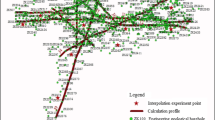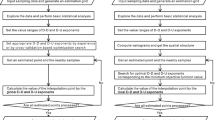Abstract
The analysis of landslides using monitoring data is a commonly used method for landslide prediction and early warning. However, the loss of data due to breakdown of the monitoring equipment or interference of external factors is unavoidable in the process of monitoring landslide data. An interpolation algorithm can supplement and correct the data to solve the problem of data loss. This multi-position and long-term monitoring data is non-linear, multidimensional and time-varying, which makes it difficult for the commonly used spatiotemporal kriging interpolation methods to construct an appropriate model straightaway. This paper presents a non-uniform spatiotemporal kriging interpolation method. It breaks through the restriction of Euclidean distance in the spatial dimension while breaking away from linear relationship in the temporal dimension. The spatiotemporal deformation field model is constructed using spatiotemporal optimal weights combination and subsequently optimized by particle swarm optimization algorithm. The ordinary kriging interpolation is extended to the non-uniform spatiotemporal kriging interpolation under the spatiotemporal constraints condition. This method is successfully applied to the interpolation of the monitoring data of landslide displacement. It provides better data for studies of landslide disasters and is of great practical significance for prevention and prediction of landslide disasters.
















Similar content being viewed by others
References
Badel M, Angorani S, Panahi MS (2011) The application of median indicator kriging and neural network in modeling mixed population in an iron ore deposit. Comput Geosci 37:530–540
Bargaoui ZK, Chebbi A (2009) Comparison of two kriging interpolation methods applied to spatiotemporal rainfall. J Hydrol 365:56–73
Bastante FG, Ordóñez C, Taboada J, Matías JM (2008) Comparison of indicator kriging, conditional indicator simulation and multiple-point statistics used to model slate deposits. Eng Geol 98:50–59
Bogaert P (1996) Comparison of kriging techniques in a space-time context. Math Geol 28:73–86
Dimitrakopoulos R, Luo X (1994) Spatiotemporal modelling: covariances and ordinary kriging systems. Springer Netherlands
Dong L, Kumar N (2013) Time-space kriging to address the spatiotemporal misalignment in the large datasets. Atmos Environ 72:60
Ertunç G, Tercan AE, Hindistan MA, Ünver B, Ünal S, Atalay F, Kıllıoğlu SY (2013) Geostatistical estimation of coal quality variables by using covariance matching constrained kriging. Int J Coal Geol 112:14–25
Gething P, Atkinson P, Noor A, Gikandi P, Hay S, Nixon M (2007) A local space-time kriging approach applied to a national outpatient malaria dataset. Comput Geosci 33:1337
Hansen TM, Mosegaard K, Schi Tt CR (2010) Kriging interpolation in seismic attribute space applied to the south Arne field, North Sea. Geophysics 75:P31
Huang H, Yi W, Yi Q, Lu S (2015) Real-time monitoring and data analysis of an active landslide in the three gorges reservoir[M]. Engineering Geology for Society and Territory. Springer International Publishing 2:1433–1436
Jost G, Heuvelink G, Papritz A (2005) Analysing the space time distribution of soil water storage of a forest ecosystem using spatiotemporal kriging. Geoderma 128:258–273
Kerwin WS, Prince JL (2002) The kriging update model and recursive space-time function estimation. IEEE Trans Signal Process 47:2942–2952
Komac M (2006) A landslide susceptibility model using the analytical hierarchy process method and multivariate statistics in perialpine Slovenia. Geomorphology 74:17–28
Lark RM, Ferguson RB (2004) Map** risk of soil nutrient deficiency or excess by disjunctive and indicator kriging. Geoderma 118:39–53
Lee W, Kim D, Chae Y, Ryu D (2011) Probabilistic evaluation of spatial distribution of secondary compression by using kriging estimates of geo-layers. Eng Geol 122:239–248
Marinoni O (2003) Improving geological models using a combined ordinary indicator kriging approach. Eng Geol 69:37–45
Metternicht G, Hurni L, Gogu R (2005) Remote sensing of landslides: an analysis of the potential contribution to geo-spatial systems for hazard assessment in mountainous environments. Remote Sens Environ 98:284–303
Naruse H, Arai K, Dan M, Takahashi H, Yamashita S, Tanaka G, Murayama M (2012) Sedimentary features observed in the tsunami deposits at Rikuzentakata City. Sediment Geol 282:199–215
Pardo-Igúzquiza E, Dowd PA, Grimes DIF (2005) An automatic moving window approach for map** meteorological data. Int J Climatol 25(665):678
Pásztor L, Szabó KZ, Szatmári G, Laborczi, A, Horváth, Á (2016) Map** geogenic radon potential by regression kriging. Sci Total Environ 544:883–891
Pokhrel RM, Kuwano J, Tachibana S (2013) A kriging method of interpolation used to map liquefaction potential over alluvial ground. Eng Geol 152:26–37
Rouhani S, Hall TJ (1989) Space-time kriging of groundwater data, vol 4, pp 639–650
Taboada J, Rivas T, Saavedra A, Ordóñez C, Bastante F, Giráldez E (2008) Evaluation of the reserve of a granite deposit by fuzzy kriging. Eng Geol 99:23–30
Tarchi D, Casagli N, Moretti S, Leva D, Sieber AJ (2003) Monitoring landslide displacements by using ground based synthetic aperture radar interferometry: application to the Ruinon landslide in the Italian Alps. J Geophys Res Atmos 108:503–518
Teng H, Shi Z, Ma Z, Li Y (2014) Estimating spatially downscaled rainfall by regression kriging using TRMM precipitation and elevation in Zhejiang Province, Southeast China. Int J Remote Sens 35:7775–7794
Webber T, Costa JFCL, Salvadoretti P (2013) Using borehole geophysical data as soft information in indicator kriging for coal quality estimation. Int J Coal Geol 112:67–75
Wolterbeek HT, Verburg TG (2004) A kriging-based estimate of the survey quality in biomonitoring of trace element air pollution. J Atmos Chem 49:15–22
Acknowledgements
This research was funded by the National Natural Sciences Foundation of China [grant numbers 41772376 and 41302278]. The authors are grateful to the editors and reviewers for kind and constructive suggestions.
Author information
Authors and Affiliations
Corresponding author
Rights and permissions
About this article
Cite this article
Liu, Y., Chen, Z., Hu, B. et al. A non-uniform spatiotemporal kriging interpolation algorithm for landslide displacement data. Bull Eng Geol Environ 78, 4153–4166 (2019). https://doi.org/10.1007/s10064-018-1388-1
Received:
Accepted:
Published:
Issue Date:
DOI: https://doi.org/10.1007/s10064-018-1388-1




